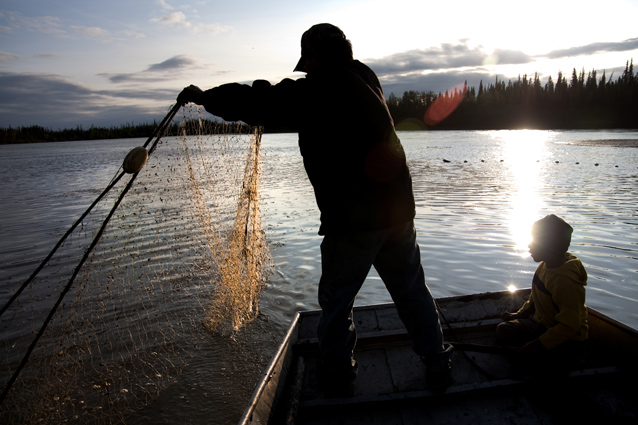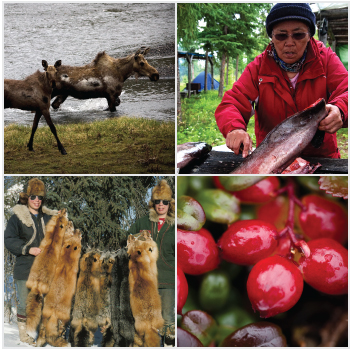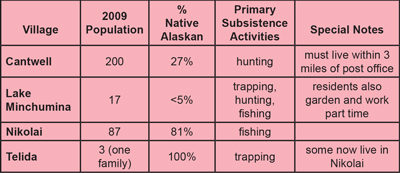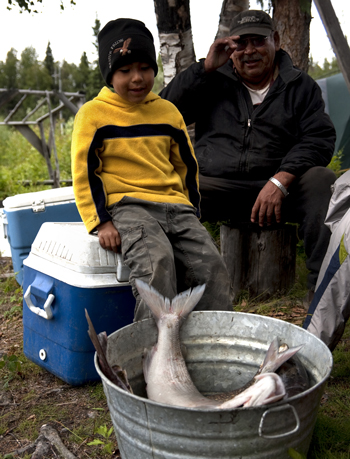
NPS Photo / Neil Blake
Once Nick had the flat-bottomed boat purring down the South Fork of the Kuskokwim away from Nikolai, his family knew they were really going to fish camp. They had been looking forward to fish camp all year. They would stay there as long as the fish were running. While they would catch fish with nets and floats set in the river, the July journey to fish camp also allows them to visit with other family members, recount stories of previous summers at camp, and gather around the campfire where Olene cooks the freshly-filleted fish and the gathered wild greens.
At fish camp, they live mostly outside, practicing a subsistence lifestyle away from the stresses of the village. Young grandson Josh learns that fish camp is a source of pride and enjoyment. Helping with the fish rack or playing with a bow and arrow at fish camp helps reinforce his Native identity. Tradition is being passed to the next generation.
For many rural residents, such as Nick and his family, but also for many rural non-Natives utilizing natural resources in and near Denali National Park and Preserve, subsistence ensures more than survival. It sustains a way of life.

NPS Photos
Subsistence and Land Conservation in Alaska
On December 2, 1980, the Alaska National Interest Lands Conservation Act (ANILCA) was signed into law. This sweeping legislation was significant for Alaska because it provided for the “enduring protection” of 100 million acres in Alaska, by adding them to the public lands managed by federal land agencies across the state. Thus, ANILCA added “new park” and “preserve” areas to the former Mt. McKinley National Park, tripling the size of what the National Park Service manages at Denali National Park and Preserve.
ANILCA ensured that local rural residents who had engaged in a subsistence way of life would be provided the opportunity to continue to do so. Thus, rural residents continue to have priority opportunities for subsistence activities in Denali’s new park and preserve lands.
Subsistence Activities in Alaska parks
The National Park Service recognizes the important connection between people and the land in Alaska and make provision for its continuance. Once ANILCA was enacted, NPS established a Subsistence Resource Commission for each Alaska park to encourage local involvement and participation associated with subsistence management.
A key component of subsistence management in national parks is to ensure the conservation of natural and healthy populations of fish and wildlife. NPS recognizes that natural systems can be different on ANILCA lands—people can be part of the ecosystem.
The goal is to incorporate scientific data and principles, together with traditional knowledge and cultural values, to keep these life-giving ecosystems unimpaired. In this way, traditional subsistence activities such as hunting, fishing, trapping, timber use for cabin construction can be perpetuated.
Denali’s 1980 enabling legislation specifies how opportunities for subsistence activities will be recognized and provided for in Denali’s new park and preserve areas, but such activities are not allowed in the “old park” wilderness.

Who is Eligible to Practice Subsistence in Denali?
To obtain a subsistence hunting permit for Denali (new park and preserve), one must be a rural Alaska resident within a designated resident zone community or have a special subsistence use permit. The resident must demonstrate that subsistence activiites have been customary and traditional for the family.
Denali has four designated resident zone communities: the villages of Cantwell, Lake Minchumina, Nikolai, and Telida (see table based on the State of Alaska community database). Residents of these communities are eligible as subsistence users of Denali without a special subsistence use permit. No permit is required for the subsistence gathering of fruit, berries, mushrooms, and other plant materials in the ANILCA additions.

NPS Photo / Neil Blake
Access for Subsistence in Denali
ANILCA authorizes use of some motorized surface transportation methods (e.g., motorboats, snowmobiles) for subsistence activities in the new park and preserve—if these methods have been traditionally employed. In Denali, off-highway vehicles (OHVs) can be used in those areas where they have been traditionally used for subsistence purposes, and only on designated trails where it has been determined that such use will not adversely affect the natural or scenic values of the park.
Denali’s Subsistence Resource Commission
The Subsistence Resource Commission (SRC) for Denali meets twice a year and is made up of nine local people who have been active subsistence users of the park. The purpose of the SRC is to recommend to the Governor of Alaska and the Secretary of the Interior a program of subsistence in Denali. Recommendations are developed to address such issues as access, customary and traditional determinations, seasonal harvest limits, eligibility for subsistence activities, cabin use, needed research, and how to reduce or avoid user conflicts.
The SRC also prepares proposals to change federal subsistence regulations and comments on other proposals that affect Denali. Denali’s SRC wants to uphold ANILCA’s provisions for subsistence to ensure that subsistence activities will continue to be available to rural residents like Nick and his family, for as long as Kuskokwim flows and boats can skim the river waters toward fish camp.
Last updated: October 27, 2021
